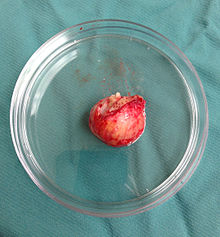Sebaceous cyst
| Sebaceous cyst | |
|---|---|
 | |
| Pronunciation | |
| Specialty | Dermatology, general surgery |
A sebaceous cyst is a term commonly used to refer to either:[1]
- Epidermoid cysts (also termed epidermal cysts, infundibular cyst)
- Pilar cysts(also termed trichelemmal cysts, isthmus-catagen cysts)
Both of the above types of
Medical professionals have suggested that the term "sebaceous cyst" be avoided since it can be misleading.[3]: 31 In practice, however, the term is still often used for epidermoid and pilar cysts.
Signs and symptoms

The
They are generally mobile masses that can consist of:
- Fibrous tissuesand fluids
- A fatty (keratinous) substance that resembles cottage cheese, in which case the cyst may be called "keratin cyst" - this material has a characteristic "cheesy" or foot odorsmell
- A somewhat viscous, serosanguineous fluid (containing purulentand bloody material)
The nature of the contents of a sebaceous cyst, and of its surrounding capsule, differs depending on whether the cyst has ever been infected.
With surgery, a cyst can usually be excised in its entirety. Poor surgical technique, or previous infection leading to scarring and tethering of the cyst to the surrounding tissue, may lead to rupture during excision and removal. A completely removed cyst will not recur, though if the patient has a predisposition to cyst formation, further cysts may develop in the same general area.
Causes
Cysts may be related to high levels of testosterone, hence may be more frequent in users of anabolic steroids.[5]
A case has been reported of a sebaceous cyst being caused by the human botfly.[6]
Hereditary causes of sebaceous cysts include
Types
Epidermoid cyst
Pilar cyst
About 90% of pilar cysts occur on the scalp, with the remaining sometimes occurring on the face, trunk, and extremities.: 1477
Treatment
This section needs additional citations for verification. (September 2007) |
Sebaceous cysts generally do not require medical treatment. However, if they continue to grow, they may become unsightly, painful, and/or infected.
Surgical
Surgical excision of a sebaceous cyst is a simple procedure to completely remove the sac and its contents,[8] although it should be performed when inflammation is minimal.[9]

Three general approaches are used - traditional wide excision, minimal excision, and punch biopsy excision.[10]
The typical outpatient surgical procedure for cyst removal is to numb the area around the cyst with a
An infected cyst may require oral antibiotics or other treatment before or after excision. If pus has already formed, then incision and drainage should be done along with avulsion of the cyst wall with proper antibiotics coverage.
An approach involving incision, rather than excision, has also been proposed.[11]
References
- ^ "Epidermoid and pilar cysts (previously known as sebaceous cysts)". British Association of Dermatologists. Retrieved April 2, 2014.
- ^ "Epidermoid and Pilar Cysts (Sebaceous Cysts) - Patient UK". Retrieved 2013-03-04.
- ISBN 978-0721690032.
- ^ "Sebaceous Cysts: Treatment & Cause". Cleveland Clinic. Retrieved 2022-02-05.
- PMID 1387354.
- PMID 12354816.
- ^ ISBN 978-0849390234.
- PMID 2349906.
- PMID 11996426.
- PMID 17403333.
- S2CID 8354318.
External links
- Overview at University of Maryland Medical Center
- Epidermal Inclusion Cyst at eMedicine
